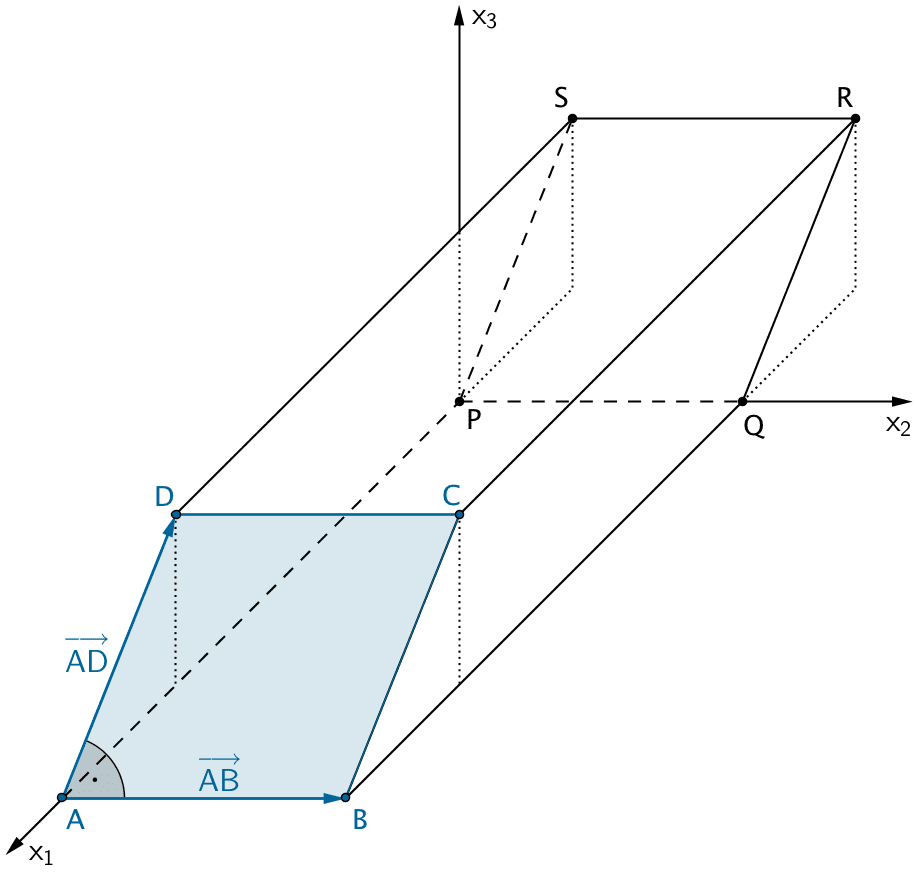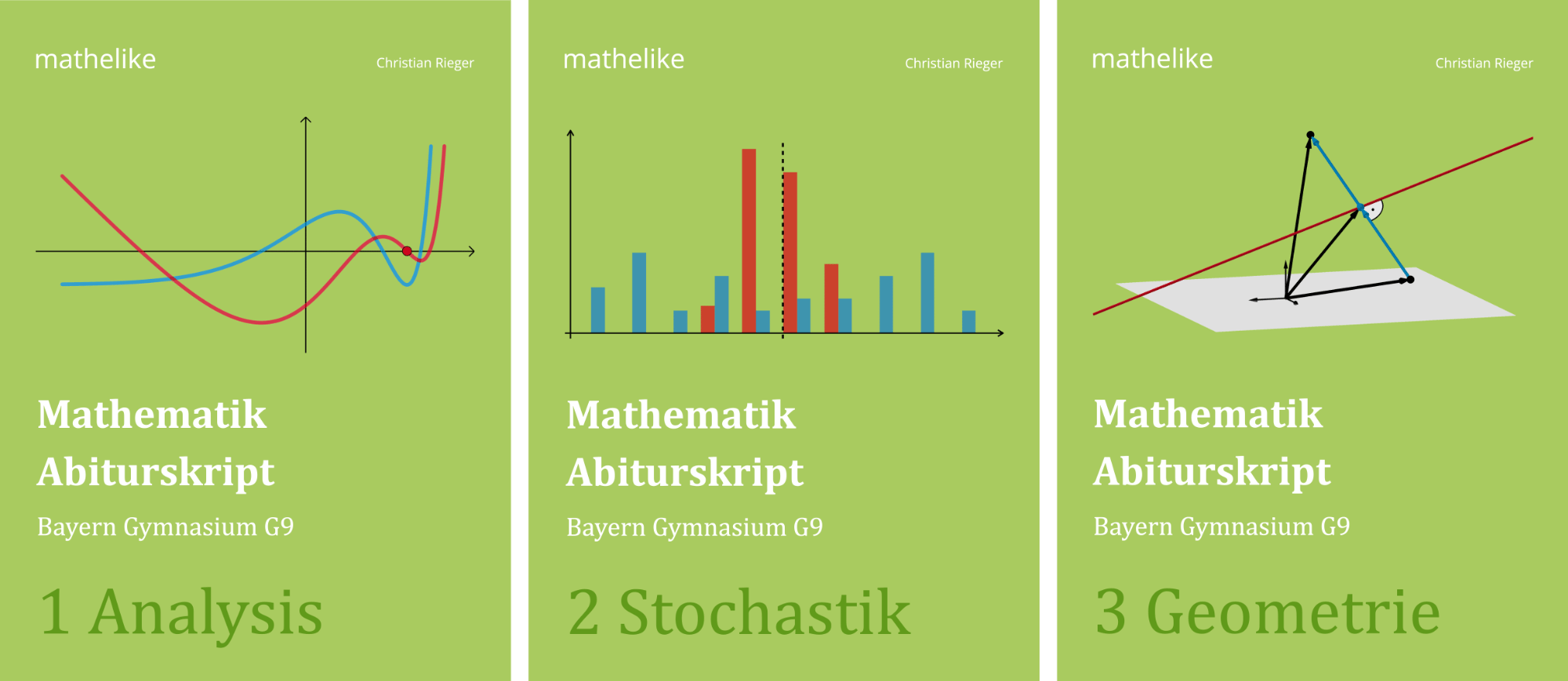Ermitteln Sie eine Gleichung der Ebene \(E\), in der die Seitenfläche \(ABCD\) liegt in Normalenform.
(mögliches Ergebnis: \(E\;\colon \, 3x_1 + 4x_3 - 84 = 0\))
(3 BE)
Lösung zu Teilaufgabe b

Die Seitenfläche \(ABCD\) repräsentiert die Ebene \(E\).
Ebenengleichung in Normalenform (vgl. Merkhilfe)
Jeden Ebene lässt sich durch eine Gleichung in Normalenform beschreiben. Ist \(A\) ein beliebiger Aufpunkt der Ebene \(E\) und \(\overrightarrow{n}_{E}\) ein Normalenvektor von \(E\), so erfüllt jeder Punkt \(X\) der Ebene \(E\) folgende Gleichungen:
Normalenform in Vektordarstellung
\[E \colon \overrightarrow{n}_{E} \circ (\overrightarrow{X} - \overrightarrow{A}) = 0\]

Normalenform in Koordinatendarstellung
\[E \colon n_{1}x_{1} + n_{2}x_{2} + n_{3}x_{3} + n_{0} = 0\]
mit \(n_{0} = -(\overrightarrow{n}_{E} \circ \overrightarrow{A}) = - \: n_{1}a_{1} - n_{2}a_{2} - n_{3}a_{3}\)
\(n_{1}\), \(n_{2}\) und \(n_{3}\): Koordinaten eines Normalenvektors \(\overrightarrow{n}_{E}\)
Richtungsvektoren der Ebene \(E\) bestimmen:
Aus Teilaufgabe a sind die beiden linear unabhängigen Vektoren \(\overrightarrow{AB}\) und \(\overrightarrow{AD}\) bereits bekannt.
\[\overrightarrow{AB} = \begin{pmatrix} 0 \\ 10 \\ 0 \end{pmatrix}; \enspace \overrightarrow{AD} = \begin{pmatrix} -8 \\ 0 \\ 6 \end{pmatrix}\]
Normalenvektor \(\overrightarrow{n}_E\) der Ebene \(E\) bestimmen:
Vektorprodukt (Kreuzprodukt)
Das Vektorprodukt \(\overrightarrow{a} \times \overrightarrow{b}\) zweier Vektoren \(\overrightarrow{a}\) und \(\overrightarrow{b}\) erzeugt einen neuen Vektor \(\overrightarrow{c} = \overrightarrow{a} \times \overrightarrow{b}\) mit den Eigenschaften:
\(\overrightarrow{c}\) ist sowohl zu \(\overrightarrow{a}\) als auch zu \(\overrightarrow{b}\) senkrecht.
\[\overrightarrow{c} = \overrightarrow{a} \times \overrightarrow{b} \quad \Longrightarrow \quad \overrightarrow{c} \perp \overrightarrow{a}, \enspace \overrightarrow{c} \perp \overrightarrow{b}\]
Der Betrag des Vektorprodukts zweier Vektoren \(\overrightarrow{a}\) und \(\overrightarrow{b}\) ist gleich dem Produkt aus den Beträgen der Vektoren \(\overrightarrow{a}\) und \(\overrightarrow{b}\) und dem Sinus des von ihnen eingeschlossenen Winkels \(\varphi\).
\[\vert \overrightarrow{a} \times \overrightarrow{b} \vert = \vert \overrightarrow{a} \vert \cdot \vert \overrightarrow{b} \vert \cdot \sin{\varphi} \quad (0^{\circ} \leq \varphi \leq 180^{\circ})\]
Die Vektoren \(\overrightarrow{a}\), \(\overrightarrow{b}\) und \(\overrightarrow{c}\) bilden in dieser Reihenfolge ein Rechtssystem. Rechtehandregel: Weist \(\overrightarrow{a}\) in Richtung des Daumens und \(\overrightarrow{b}\) in Richtung des Zeigefingers, dann weist \(\overrightarrow{c} = \overrightarrow{a} \times \overrightarrow{b}\) in Richtung des Mittelfingers.
Berechnung eines Vektorprodukts im \(\boldsymbol{\mathbb R^{3}}\) (vgl. Merkhilfe)
\[\overrightarrow{a} \times \overrightarrow{b} = \begin {pmatrix} a_1 \\ a_2 \\ a_3 \end {pmatrix} \times \begin {pmatrix} b_1 \\ b_2 \\ b_3 \end {pmatrix} = \begin {pmatrix} a_2 \cdot b_3 - a_3 \cdot b_2 \\ a_3 \cdot b_1 - a_1 \cdot b_3 \\ a_1 \cdot b_2 - a_2 \cdot b_1 \end {pmatrix}\]
\begin{align*} \overrightarrow{AB} \times \overrightarrow{AD} &= \begin{pmatrix} 0 \\ 10 \\ 0 \end{pmatrix} \times \begin{pmatrix} -8 \\ 0 \\ 6 \end{pmatrix} \\[0.8em] &= \begin{pmatrix} 10 & \cdot & 6 & - & 0 & \cdot & 0 \\ 0 & \cdot & (-8) & - & 0 & \cdot & 6 \\ 0 & \cdot & 0 & - & 10 & \cdot & (-8) \end{pmatrix} \\[0.8em] &= \begin{pmatrix} 60 \\ 0 \\ 80 \end{pmatrix} = 20 \cdot \begin{pmatrix} 3 \\ 0 \\ 4 \end{pmatrix}\end{align*}
\[\Longrightarrow \quad \overrightarrow{n}_E = \begin{pmatrix} 3 \\ 0 \\ 4 \end{pmatrix}\]
Ebenengleichung in Normalenform in Vektordarstellung aufstellen:
Es sei \(A\,(28|0|0)\) der Aufpunkt der Ebene \(E\).
\[\begin {align*} \Longrightarrow \quad &E \, \colon \; \overrightarrow{n}_E \circ \left( \overrightarrow X - \overrightarrow A \right) = 0 \\[0.8em] &E \, \colon \; \begin {pmatrix} 3 \\ 0 \\ 4 \end {pmatrix} \circ \left[ \overrightarrow{X} - \begin {pmatrix} 28 \\ 0 \\ 0 \end {pmatrix} \right] = 0 \end {align*}\]
Ebenengleichung in Normalenform in Koordinatendarstellung bestimmen:
Skalarprodukt
Unter dem Skalarprodukt \(\overrightarrow{a} \circ \overrightarrow{b}\) zweier Vektoren \(\overrightarrow{a}\) und \(\overrightarrow{b}\) versteht man das Produkt aus den Beträgen der beiden Vektoren und dem Kosinus des von den Vektoren eingeschlossenen Winkels \(\varphi\).
\[\overrightarrow{a} \circ \overrightarrow{b} = \vert \overrightarrow{a} \vert \cdot \vert \overrightarrow{b} \vert \cdot \cos{\varphi} \quad (0^{\circ} \leq \varphi \leq 180^{\circ})\]
Berechnung eines Skalarprodukts im \(\boldsymbol{\mathbb R^{3}}\) (vgl. Merkhilfe)
\[\overrightarrow{a} \circ \overrightarrow{b} = \begin{pmatrix} a_{1} \\ a_{2} \\ a_{3} \end{pmatrix} \circ \begin{pmatrix} b_{1} \\ b_{2} \\ b_{3} \end{pmatrix} = a_{1}b_{1} + a_{2}b_{2} + a_{3}b_{3}\]
\[\begin {align*} \begin {pmatrix} 3 \\ 0 \\ 4 \end {pmatrix} \circ \left[ \overrightarrow{X} - \begin {pmatrix} 28 \\ 0 \\ 0 \end {pmatrix} \right] &= 0 \\[0.8em] 3 \cdot (x_1 - 28) + 0 \cdot (x_2 - 0) + 4 \cdot (x_3 - 0) &= 0 \\[0.8em] 3x_1 - 84 + 4x_3 &= 0 \end {align*}\]
\[E\,\colon\; 3x_1 + 4x_3 - 84 = 0\]


